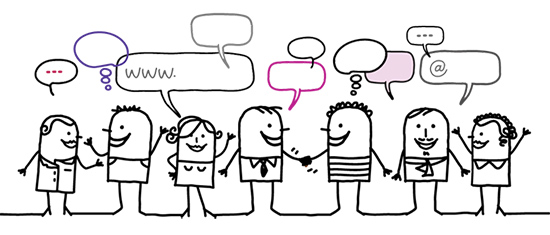
The popularity of emails started in the late 1990s.
Back then, emails were used as the primary communication source, and for quite some time, most businesses saw emails as the most efficient communication tool for both external and internal communication.
This is no longer the case.
The average employee spends around 13 hours a week reading emails and responding.
This is taking up 28% of his working life.
Although emails can still support effective communication for some, when it comes to creating an effective internal communication strategy, it’s time to look elsewhere.

Here we take a closer look at the most important reasons why an email can no longer be used as the only internal communication tool. It’s time you consider an internal blog as your alternative, and here are 8 reasons why.
#1 The Psychology of Email Is Ambiguous
The very nature of emails is focused on textual expression. Simply, emails were designed to generate more emails and more conversations and were created to provide quick and short answers.
However, we started using them in a different way, writing long paragraphs and attaching too many files.
With so many chat apps and collaboration tools we use today, emails can easily create more internal communication problems. Modern work-related communication has been moving to social media as well. Moreover, social media has become second nature to millennials and generation Z.

Why the internal blog is a better option?
Tech and software companies are designing and developing communication tools to enhance employees' experience, support action, and proactivity, and engage users in an interactive way. A variety of such tools you can easily test with only one click.
In the modern business environment, emails have become obsolete tools for internal communication. Unlike emails, an internal blog provides you with more options and features to effectively use content and still get the necessary feedback and response.
#2 The Human Connection Via Email Can Be Misinterpreted
Most have forgotten but before email communication, we spoke with each other. This direct interaction was the ground for both internal and external communication. However, we quickly replaced face-to-face interaction and communication with email communication.
Were you ever surprised by someone’s response to your email? Did you make any bad decisions as a result of misunderstandings in email threads?
Although emails can be effective communication channels, good internal communication is based on different communication channels.
Moreover, based on the tools that suit your needs and company culture. But, when the internal communication strategy is solely (or mostly) based on email communication, you can expect a misunderstanding.
If your answer to the previous questions is YES, it’s time you explore new communication tools that can help you empower internal communication.

Irish proverb
How does the internal blog support human connection?
If you are considering testing the internal blog, you can rest assure that misunderstandings cannot take place. The published information is available all the time to everyone and it’s easy and fast to edit the content anytime. Moreover, by having the content available for everyone to see, you can also spark live discussions and conversations in the team or between departments and enhance face-to-face communication.

If are not sure where to start, test the features and options we created for our internal blog.
#3 Emails Are Gone Once They Are Sent
There’s no edit option once the email is sent. Surely, there is an option to delete it, but will you have time to re-read your email before you send it - every day?
Unlike emails, the internal blog provides you with effective publishing options. Once you publish the post, you can easily edit the content, attach documents or files, add links, or any information you might have missed.
#4 Emails Can Be Too Long And Comprehensive
With technological advancement, the workplace is rapidly changing. Our multi-generation workplace does not only bring new technologies but new ways of organization, approach to work, and work ethics.
Younger team members are more comfortable communicating via a number of chat apps, online collaboration platforms, video calls, even complex project management services.
Different communication needs are met using different communication tools.
In the working environment, where too many messages are sent and received over too many channels - long, comprehensive emails are only adding up to the overload of channels, messages, and apps the employees are already using.
Yes, you can write a short email, but the form itself is inviting one to keep on writing.
If/when the email is used as a tool for internal communications - the risk to have messages deleted or skimmed is increasing by minutes. Or even seconds.

What about the internal blogs?
With the internal blog, you can organize and create content the way that suits you and the way your team or employees understand the best.
#5 Emails Can Significantly Contribute To The Information Overload
Let’s point out one simple fact: By the end of 2023, the number of worldwide email users is expected to grow to over 4.3 billion.
An email is primarily a working tool, but the sheer number of messages we receive in our inboxes is overwhelming.
By the end of this year, the total number of emails businesses and consumers will send or/and receive per day is going to be more than 293 billion.
Emails are getting lost or forgotten. They are also deleted. The subscription is fast and simple. However, only one email can be distracting, a person needs up to twenty-five minutes to refocus on work after reading an email.
The average office worker receives 121 emails per day. That’s 121 ways a person can get distracted from that task throughout a day missing the important email you have sent. In the end, consider a number of newsletters and blogs a person subscribes to.
All this means that emails can easily become a source of distraction and information overload.

Peter Drucker
Can internal blogs be a source of distraction?
Internal blogs are not supporting activities or actions that are distracting a person from important work. Once you publish the post or share information, you can decide how to inform your team about it. You can send notifications about it right away, or you can send it on a weekly or monthly basis. Each user can also choose how the notifications are sent and when.
#6 Emails Cannot Truly Support Media Versatility
Emojis, videos, and memes are starting to replace text. Yes, you can attach the files and provide links in the body of your email, but both senders and receivers are limited in the way they want to express themselves.
Email is primarily a text-based communication tool, and oftentimes the recipients are unable to provide feedback they would prefer.
The fact that emails don’t support media richness is a great disadvantage if your recipients are Generation Z and millennials, another important notion.
In numbers, 80% of employees enjoy using gamification software at work, according to research. Why?
For over 80% of respondents, gamification at work is desirable because it makes them:
-
feel more socially connected (i.e. relatedness)
-
gives them a greater sense of creativity, choice, freedom, and/or responsibility (i.e. autonomy)
-
helps them develop personally and professionally (i.e. mastery).
Moreover, employees feel that gamification makes them more productive (87%), more engaged (84%) and happier (82%) at work.

to ensure your communications are relevant. - Andrea Plos
What media and visuals can you use in the internal blog?
On the other side, an internal blog is created to give you more tools and features you can use to send your message. Whether you want to use GIFS, videos or images, and links, you are not limited in choices. Keep in mind that it’s equally important what media you use to send your message.
It’s time you ask yourself again whether an email is a tool you should be using for your internal communication.
#7 Emails Rarely Provide A Needed Employee Feedback
If the email even finds its way to you and you read it, how many times have you replied? How many times have you provided feedback?
There’s always an excuse one can find for not replying. Whether it’s a lack of time or one does not want to speak openly in this communication form.
Ever since modern interactive communication tools were introduced, both business and internal communication have significantly changed.
Millennials and Generation Z who are impacted by these new channels do not only require feedback but openly and willingly share their opinion. To meet their needs, more and more communication tools and channels encourage interactive conversation. In this environment, giving feedback via email simply requires more time and a lot of work.

listen not just to the words, but listen for the reason.
- Catherine Pulsifer
How does the internal blog empower employees to give feedback and participate in discussions?
Asking and giving feedback via the internal blog is simple, fast, effective, and straightforward.
One can choose when to receive notifications once someone leaves a comment or link, group certain topics, and comments, and use all the benefits provided by the internal wiki to organize content and feedback.
#8 Spam Filters May Hide Important Messages From You
Spam accounts for 48.16% of email traffic worldwide, Statista reports.
To put it differently, we receive around 12K spam emails on a daily basis - without noticing.
Luckily, spam filters are effective in keeping our inboxes safe, but these tools are not perfectly developed. Companies are working to make them better, and with the improvement comes more protection and safety.
The irony is that with more protection, more is the possibility that we will not receive important messages in our inbox.
Unless we get an email message in our inbox, the message is lost for us. There will always be at least one email in the spam folder that one would’ve wanted to know about.
Do you have time to go through your spam folder? No one does.
If or WHEN the important email message ends in the spam folder, we cannot talk about effective employee engagement or good internal communication.

Do you get spam messages if you use the internal blog?
There are no spam messages in the internal blog. A user can organize and set up the preferable ways of receiving notifications, replies, email newsletters, and more.
What are your options?
Passive internal communication cannot enhance motivation or action or create social responsibility.
Communication has become faster. Communication channels have become easier in many ways.
Regardless of the industry, all employees want to be able to:
-
Share their opinion and be heard
-
Get an opportunity to be actively involved
-
Use interactive communication tools to better share their feedback
-
Spend less time on tasks that drain their energy and creativity
-
Be an active part of the community
Can email provide all the above?
No, it cannot.
This is where the internal blog steps in as an effective communication tool.
Your next step
The abundance of communication channels available today can easily lead to confusion leaving business owners indecisive and overwhelmed.
If you are not sure how an internal blog supports employee’s engagement and their communication needs, sign up for our free trial and test it.
